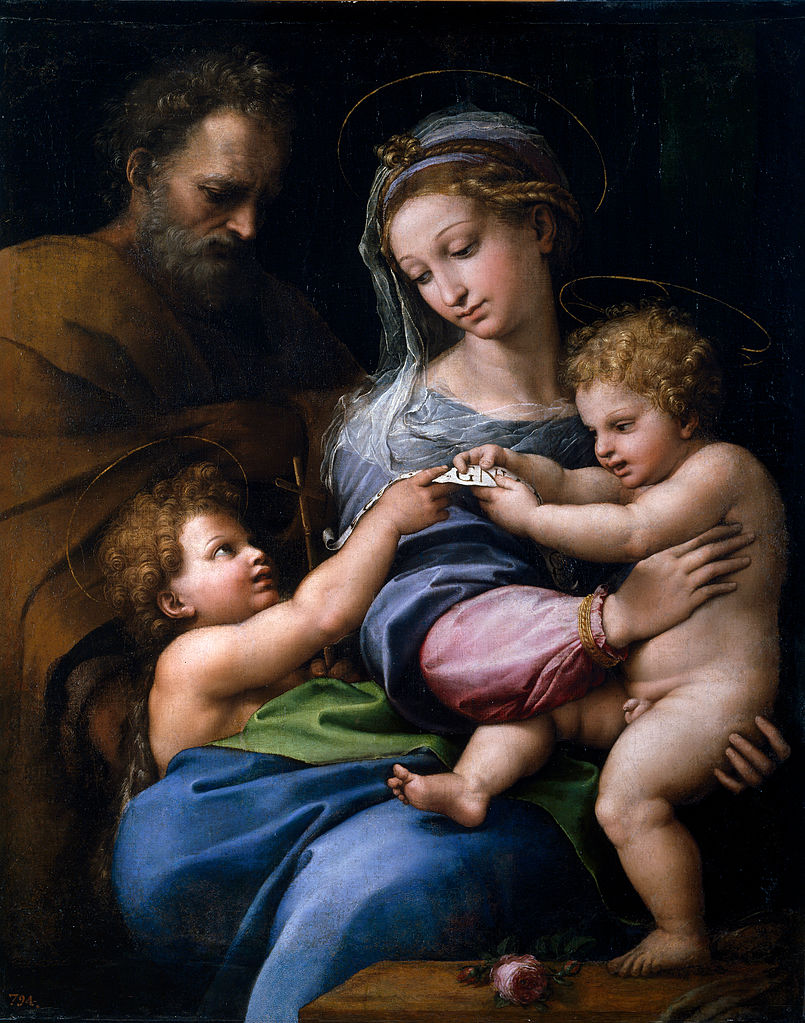The Holy Family with the Infant Saint John the Baptist, or Madonna of the Rose
Story
The first verified Spanish documentation of Holy Family with the Infant Saint John the Baptist or Madonna of the Rose, c. 1517, dates from 1657. In 1642 Wenceslaus Hollar engraved this composition after a painting belonging to Thomas Howard, 21st Earl of Arundel, one of the present work’s probable owners. However, there were copies of the work in Spain in the sixteenth century, including no less than six listed in the 1589 testament of Beneditto Rabuyate, a Florentine painter active in Valladolid. Other copies include one from the collection of the Count of Monterrey (Museo de Valladolid) and a version by Gabriel de Cárdenas (Museo del Prado). Moreover, in 1633 Vicente Carducho mentioned a poorly conserved painting by Raphael in his workshop, which may have been this one.
Originally painted on panel, the composition may have been transferred to canvas during the first half of the nineteenth century, when its dimensions would have been modified (from 96.8 x 81.0cm) and a lower section added, bearing the rose that gives the work its popular name. The absence of the original support and the degree of surface abrasion make it difficult to date, but it may have been painted around 1517. The circumstances surrounding the work’s commissioning are unknown, although there is no doubt about its attribution to Raphael.
Nevertheless, the traditional interpretation of that artist’s Roman works -as puzzles in which different members of his workshop painted one part or another- has led some specialists to consider the participation of the bottega in the rendering of anecdotal parts of the figures.
Recent studies of Raphael’s later works have shown that the methods of collaboration were very sophisticated, always supervised by the master and limited to large-format works. The intimate character of the present image, accentuated by the melancholic attitudes of Saint Joseph and Mary, its delicate lighting and the presence of a curtain in the background suggest that it was an altar panel for a private chapel.
In this work Raphael partially returns to his compositions from the beginning of the second decade of the sixteenth century, which were still very Florentine, but his treatment of colour and light resemble the Madonna of the Pearl, 1518 (Museo del Prado), and recall the influence of Leonardo and Fra Bartolomeo evident in his final works. The formal simplicity of the bodies and their secure placement in space indicate that the work was painted rapidly on the basis of learned models. Its rendering is very careful, despite the limited colour scheme: the blues overlap a pink layer, the flesh tones are rendered with very thin coats of paint, and the shadows and hair approach the levels of transparency attained in Madonna of the Pearl. There are two later versions: the Novar Munro Madonna, 1550-60, by Giulio Romano, and a panel attributed to Daniele da Volterra at the Galleria Doria Pamphilj, Rome
